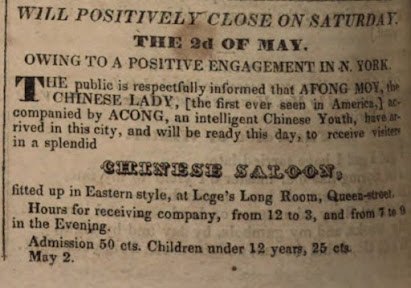Detail of Afong Moy (1815@ to ?). The Chinese
Lady
Courtesy of the New York Public Library Digital Collections
When Afong Moy appeared in Providence, Rhode
Island, in 1835, the local newspaper encouraged all to go see the first female
visitor to the United States from China. The editor argued the Chinese Lady
served as a “living specimen” of a culture known of but not truly experienced. Children
learned of the many dynasties in school. Americans drank Chinese tea and possessed
a considerable number of goods from China: fans, combs, shawls, baskets, games,
porcelain, and silks. Women learned from magazines how to dress and style their
hair in the Chinese fashion. Few Americans, however, had traveled to Asia or
had encountered anyone from the region. The Providence newspaper pointed out
that this event was a perfect chance for many to learn about the customs of a
culture “which is so different from anything with which they have been
acquainted.”
Rural
Repository (Hudson, NY) February 28, 1835, 159
Americans learned about China from Afong Moy and
in turn made her a celebrity. They attended her performances in large numbers
wherever she traveled, paying twenty-five to fifty cents each. Fans pasted
newspaper reports in their diaries and commented on their experiences. Teen-aged
Margaret Gibson sympathized with Afong Moy in her letter to her brother. She
wrote “Poor thing she is much to be pitied, she seemed
very timid, and confused.” A Baltimore woman dressed as her for a
masquerade ball. Race horse breeders named fillies after her. Men wrote poems
in her honor; William Tappan of Cincinnati published one that began “I marvel
at thy curious mien, thy strange, fantastic air.” Newspapers widely reported
on her tour and spread rumors of her marriage prospects, her alleged disappearance,
and the likelihood of her publishing a journal of her travels.
And those travels were extensive. Afong Moy
arrived from China in 1834 when she was about nineteen, accompanied by a maid
and an American female chaperone. Historians know little of her background or
even her true name, but she was likely the daughter of a merchant in the city
of Guangzhou. American traders arranged her passage across the ocean and her
presentation to audiences in the United States as a promotion for the goods
they were selling. They created a setting filled with Chinese art and furniture
where she could (with help from an interpreter) share elements of her culture
such as dress, song, her bound feet, and eating with chopsticks.
Afong Moy apparently believed she would be returned
to her home after one year. She appeared before audiences in New York,
Philadelphia, Washington, DC (where she met President Andrew Jackson),
Baltimore, Charleston, Boston, Providence, and many smaller communities
throughout New England. She experienced a grueling schedule but rather than
travel back to China after a year, she continued on the road with an
entertainment manager, covering one thousand miles in 1836. She performed,
along with musicians and magicians, in Florida, Cuba, New Orleans, and towns
all up the Mississippi River before returning to audiences in New York City. Afong
Moy saw more of America than most of its citizens. Unfortunately she never
published a journal and we know nothing of her perspective.
Advertisement in Southern Rose Bud (Charleston, SC) May 2, 1835, 144
She could have used the royalties from a book
since, though a star, she was not wealthy. When audience numbers declined in
1837, she found herself hobbled by her bound feet and alone in a New Jersey poorhouse.
Those who had taken care of her were gone: her maid, chaperone, manager, and
interpreter. Outraged fans publicized her plight and newspapers across the
country printed demands that she be helped to return to China. She received
much needed money but no opportunity to go home.
Alexandria Gazette, November 13, 1849
P.T. Barnum revived her career in 1847 when
Americans had a renewed interest in everything Chinese but he replaced her with
a younger woman from China by 1850. In 1851 Afong Moy performed in Cleveland,
but it is unknown what happened to her after that. She remained the first
Chinese woman in America but others had followed. She died in obscurity but not
as a specimen.
Sources
Davis,
Nancy E. The Chinese Lady: Afong May in
Early America. New York: Oxford University Press, 2019.
“Extraordinary
Arrival—The Young Chinese Lady.” Alexandria
Gazette October 21, 1834. https://chroniclingamerica.loc.gov/lccn/sn85025007/1834-10-21/ed-1/seq-2/#date1=1789&index=0&rows=20&searchType=advanced&language=&sequence=0&words=Foo-chee+Julia&proxdistance=5&date2=1963&ortext=&proxtext=&phrasetext=julia+foochee&andtext=&dateFilterType=yearRange&page=1
“Margaret
S. Gibson to John Gibson” Maryland Historical Society, quoted in Davis, Chinese Lady, 158-159.
Haddad,
John. “The Chinese Lady and China for the Ladies: Race, Gender, and Public
Exhibition in Jacksonian America.” https://www.chsa.org/wp-content/uploads/2012/01/2011HP_02_Haddad.pdf
Republican Herald (Providence,
RI) Sept. 2, 1835, quoted in Davis, Chinese
Lady, 182.
Tappan,
William. The Poems of William B. Tappan. Philadelphia:
Henry Perkins, 1836. https://babel.hathitrust.org/cgi/pt?id=loc.ark:/13960/t4hm5sm1q&view=1up&seq=5
Thanks
for reading! Have a question or comment? Let me know!
To subscribe, email angela.firkus@gmail.com





No comments:
Post a Comment